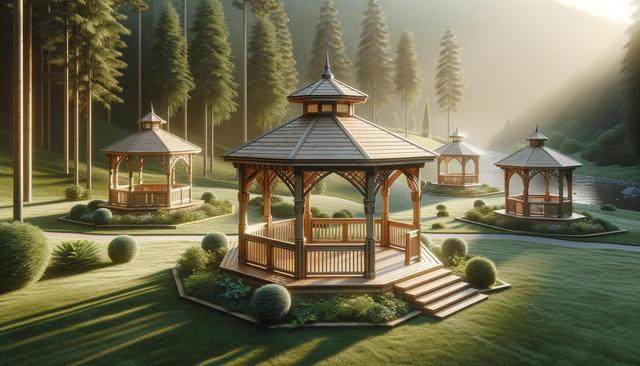
Discover the Beauty and Versatility of Wooden Gazebos
Understanding the Different Types of Wooden Gazebos
Wooden gazebos come in various designs, each catering to different functional and aesthetic preferences. The type you choose can influence not only how you use the space but also how it complements your garden. Traditional octagonal gazebos, for instance, offer a classic look and are often used as decorative focal points. Rectangular or square gazebos are more practical for dining and entertaining, providing ample space for furniture and guests.
Some of the most popular wooden gazebo types include:
- Open-air gazebos – Ideal for panoramic views and natural airflow.
- Enclosed gazebos – Provide more privacy and protection from the elements.
- Pavilion-style gazebos – Great for larger gatherings and events.
- Pergola hybrids – Combine the structure of a gazebo with the open roofing of a pergola for a lighter feel.
Each type can be customized with features such as railing, lattice walls, or built-in benches, allowing you to tailor the design to your exact needs and preferences.
Materials and Construction Considerations
The type of wood used in a gazebo can significantly affect its durability, appearance, and maintenance needs. Common choices include cedar, redwood, and pressure-treated pine. Cedar is favored for its natural resistance to pests and decay, while redwood is known for its rich color and longevity. Pressure-treated wood is a cost-effective option that offers good protection against rot and insects, though it may require more frequent maintenance to preserve its appearance.
The construction process also matters. Prefabricated gazebo kits are widely available and offer convenience, while custom-built gazebos provide greater design flexibility. Factors to consider when planning construction include:
- Size and placement in your yard
- Foundation and anchoring requirements
- Roofing materials (shingles, metal, or polycarbonate)
- Local building codes and permits
Proper sealing and staining help extend the life of wooden gazebos, and routine maintenance such as cleaning and reapplying protective finishes ensures they remain visually appealing and structurally sound.
Functional Uses for a Wooden Gazebo
Wooden gazebos serve a variety of purposes beyond just being a beautiful outdoor structure. Their versatility makes them suitable for both casual and formal settings. In residential gardens, they are commonly used for:
- Outdoor dining areas with tables and chairs
- Lounge spaces with cushioned seating
- Hot tub enclosures offering shade and privacy
- Yoga or meditation retreats
Gazebos can also enhance commercial landscapes such as resorts or public parks, providing shaded resting areas or elegant venues for small events. When equipped with lighting, curtains, or mosquito nets, a wooden gazebo becomes a year-round outdoor living space, adding comfort and utility regardless of season.
For those who enjoy entertaining, a gazebo is a practical addition that supports social gatherings, barbecues, and alfresco meals. It creates a defined space that feels like an extension of the home, bringing indoor comforts into the backyard.
Price Range and Budgeting Tips
The price of a wooden gazebo can vary greatly depending on size, material, customization, and installation type. On average, a small, prefabricated gazebo can start around a few hundred dollars, while larger, custom-built models with high-end materials may reach several thousand dollars. Here’s a general breakdown:
- Basic kits (6×6 ft to 8×8 ft): $500 – $1,500
- Mid-size models (10×10 ft to 12×12 ft): $2,000 – $4,000
- Large or custom gazebos: $5,000 and up
Additional costs may include foundation preparation, roofing upgrades, built-in seating, and electrical work if you’re adding lighting or outlets. To budget effectively, consider the purpose of your gazebo and prioritize features accordingly. Investing in quality wood and protective treatments can reduce long-term maintenance costs and extend the life of your structure.
Hiring a professional installer ensures proper assembly and compliance with local regulations, although handy homeowners may opt for DIY kits to save on labor. Either way, clear planning and budgeting help avoid unexpected expenses during the process.
Design Enhancements and Personalization Ideas
Personalizing your wooden gazebo can transform it from a simple shelter into a unique outdoor retreat. Design enhancements can reflect your style and maximize the functionality of the space. Consider adding decorative elements such as:
- Hanging plants or trellises with climbing vines
- Ambient lighting like string lights or lanterns
- Weather-resistant curtains or screens
- Outdoor rugs and cushions for comfort
For those looking to use the gazebo year-round, adding side panels or retractable walls can help protect against wind and rain. Heating elements like portable heaters or fire pits (used safely) can also extend usability into cooler months. For tech-savvy users, built-in Bluetooth speakers or solar-powered lighting enhance the experience without the need for extensive wiring.
Matching your gazebo’s design to your home’s architecture or garden theme helps create a cohesive look. Whether rustic, modern, or traditional, thoughtful design choices ensure your gazebo is more than just a structure—it becomes a cherished part of your outdoor lifestyle.
Conclusion: Choosing the Right Wooden Gazebo for Your Space
Wooden gazebos offer a harmonious blend of form and function, providing a timeless addition to any outdoor setting. Whether you’re seeking a tranquil retreat, a stylish entertaining area, or a functional garden centerpiece, there’s a gazebo style and size to match your vision and budget. By understanding the types, materials, uses, and costs involved, you can make informed decisions that enhance your yard and lifestyle. With proper care and thoughtful design, a wooden gazebo becomes an enduring space for relaxation and enjoyment for years to come.


